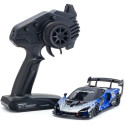Mini-Z buying guide: all models and their differences
The flagship of the Kyosho brand, created in 1999, the mini-Z has undergone numerous evolutions and improvements since its creation.
The Kyosho Mini-Z is a range of small-scale radio-controlled cars offering a dynamic yet accessible model-building experience.
Designed for model enthusiasts who want to keep up their training between races or indoor in winter (racers), but also for beginners, Mini-Zs are famous for their precision, amazing design and exceptional performance, despite their small 1/28 scale.
Each model can be equipped with advanced technologies such as brushless motors, independent suspensions and top-of-the-range steering systems, enabling the reproduction of realistic, fluid driving sensations.
One of the great assets of the Kyosho Mini-Z is the possibility of customizing the cars with a variety of spare parts and accessories, from bodywork to tires and motors. These models are also renowned for their sturdiness and ease of maintenance, making them an excellent choice for those wishing to enter the world of radio-controlled cars.
Thanks to compact circuits and specially designed tracks of various sizes, Mini-Zs can be upgraded for exciting racing indoors, and are perfect for urban environments or small spaces.
Finally, the sociable aspect of the sport is reinforced by the existence of clubs and events dedicated to these vehicles, creating a passionate community around the Kyosho Mini-Z.
In short, the Kyosho Mini-Z represents an ideal compromise between performance, customization and driving pleasure.
When we write those lines, there are many models available for lovers of this category and of the brand, but also and above all for drivers of all levels who want to drive a real racing car, a perfect replica of existing models that have marked or are marking racing car history!
With its incredible performance for its small 1/28 size (around 100mm on average) and its unique realism, the mini-Z will enable beginners to learn how to drive their first radio-controlled car, as well as experienced drivers to improve their precision and consistency!
In 2024, there are 3 types of mini-Z on the market, marketed as Readyset (all included in the box with radio):
- Mini-Z buggy
- Mini-Z AWD
- Mini-Z FWD (discontinued)
- Mini-Z RWD
Mini-Z buggy

Genuine miniature buggy with 4-wheel drive. It's a replica of the brand's world-champion 1/8 competition buggies.
The chassis easily overcomes small bumps and gaps, making circuits even more fun! It can even tackle short grass, gravel or sand.
It features 4x4 transmission and suspension with 4 independent shock absorbers.
Mini-Z Buggy models generally run on NiMH rechargeable batteries. Autonomy depends on battery type, but can last between 20 and 30 minutes on a full charge, depending on driving style and terrain.
Look at that buggy look!
Mini-Z AWD

One of the main features of this model is its AWD (All-Wheel Drive) transmission.
This system offers excellent stability and enables the Mini-Z AWD to behave very precisely, even on slippery or uneven surfaces.
These cars are usually fitted with WRC or rally-style bodywork and drift tires. They are not, however, made for rough conditions, with limited ride height compared to the Mini-Z buggy off-roader.
4WD traction ensures a better distribution of power to all four wheels, for better cornering and optimized acceleration performance.
The Mini-Z AWD generally uses rechargeable NiMh batteries, which enable it to reach interesting speeds for its scale while offering a range of 20 to 30 minutes, depending on the type of driving and terrain.
While the Mini-Z AWD is ready to roll right out of the box, it also offers a wealth of customization and tuning possibilities. You can adjust the suspension, change the motors and even modify the bodywork to match your personal preferences or to optimize the car for specific races.
Mini-Z FWD

A front-wheel-drive (FWD) model, it was abandoned in favor of the other models. The possibilities were indeed limited, with understeer on the track and less fun to drive. It is now discontinued.
Mini-Z RWD

This is the most widespread category, and also the one most used in competition. It's the one with the most options, Autoscale bodywork and customization.
Choosing a Kyosho Mini-Z RWD (Rear-Wheel Drive) can offer a unique and captivating experience for RC model enthusiasts, especially those looking for a vehicle with a greater focus on driving realism and more technical handling. These models feature rear-wheel drive.
Here are several reasons why you might opt for a Mini-Z RWD:
The main advantage of a Mini-Z RWD is that it offers a ride very close to that of real cars, especially sports or racing vehicles. Unlike AWD (four-wheel drive) versions, which are easier to drive and offer greater stability, an RWD (rear-wheel drive) car transmits power to the rear wheels, creating a more realistic and demanding driving experience, especially when cornering.
On an RWD Mini-Z, it's easier to feel how power and torque are managed when cornering, giving a better understanding of the principles of rear-wheel-drive driving.
Better grip for experienced drivers:
For drivers already experienced with radio-controlled cars, the Mini-Z RWD offers an extra level of difficulty compared with all-wheel-drive models, so it's a better practice to keep focus and sharp!
Indeed, a rear-wheel drive car tends to be a little more difficult to control, as it can slide or skid more easily, especially if you press too hard on the throttle when cornering. This requires a certain precision in the controls and good power management.
The RWD will therefore offer a greater challenge for those looking to refine their driving technique, for all categories of RC cars.
Rear-wheel drive makes the Mini-Z RWD more agile in tight turns, as it can pivot more easily on its axis.
Share this content











